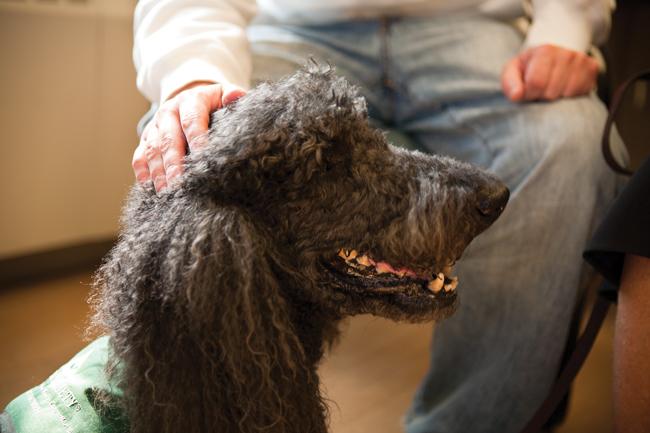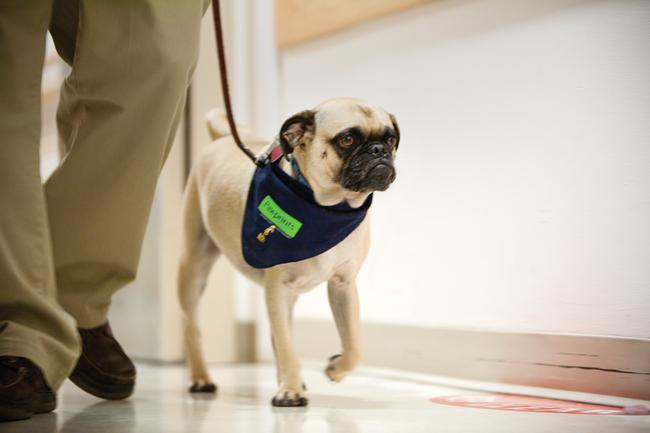Dog Tales
The trauma of illness can be soothed by the unspoken compassion of canines
- Feature

When Phil walks into Boston Children’s Hospital, heads turn. Although he seems not to notice, Phil is not unlike other celebrities. He knows when those around him are paying attention. In fact, that’s one of the aspects of his character that his coworkers at Children’s admire. Phil can sense what patients need, usually without their saying a word. Most often that need is simply a friendly paw.
Phil and his canine colleague, Cosmo, who works at Beth Israel Deaconess Medical Center, are visitation dogs, volunteers in one of the animal-visitation and animal-assisted therapy programs active at the hospitals affiliated with HMS. With their official hospital badges, calm temperaments, and repertoire of tricks sure to please any patient they encounter, Phil, Cosmo, and their dozens of tail-wagging fellow volunteers offer patients, families, doctors, and nurses a welcome diversion from the normal hospital routine. Yet the increasing presence of these working dogs at hospitals may signal something else: The growing use of pet therapy could represent a trend toward providing patients with a more holistic healing environment.
The idea of using animals to help humans heal is not a new one. One of the earliest recorded uses of structured animal-assisted therapy was in ninth-century Belgium, where therapie naturelle was provided to handicapped residents of Gheel. In the late eighteenth century, animals were a part of an alternative treatment program provided to mentally ill patients who resided at the York Retreat, a Quaker-funded institution in England. The retreat’s program eventually became a model for reform in similar institutions.

Research investigating the validity of animal therapy, however, lagged behind these clinical applications. Scientists did not begin to look critically at the psychological and physiological benefits of animal therapy until the late nineteenth century, when scholars were exploring the idea that humans are part of the animal kingdom and, therefore, subject to its laws. They also began to ponder the fact that behaviors originally attributed only to humans were displayed by other animals as well. These explorations eventually led to the development of animal studies, a cross-disciplinary field that investigates animal behaviors through anthropology, biology, history, psychology, philosophy, and sociology. By combining these perspectives, researchers hope to produce an understanding of human–animal relations, and, by extension, to better define what it means to be human.
Hospitals such as Children’s and Beth Israel Deaconess are building upon these investigations by considering how the concepts behind human–animal relations can be applied to patient care. One route of investigation is through animal-visitation programs, such as those that employ Phil and Cosmo.
“As institutions are investigating how to be more patient-centered, they’re looking at the emotional health of the patient, which could have big implications for physical health,” says Aimee Lyons, director of nursing and patient services in the medical and surgical intensive care unit at Children’s.
Animal therapy is a goal-directed intervention program in which an animal that meets behavioral and health criteria can play an integral part in treatment. Health and human service professionals direct and deliver these programs with the goal of improving patients’ physical, social, emotional, and cognitive functioning.
First in Show
An indication of how the dogs help achieve these goals can be seen in the visits Phil makes during a typical round. Sometimes he meets a child in his or her room. Other times, he waits for children to gather in the oncology floor’s playroom. On a recent visit, Phil waited patiently in the playroom for children to arrive. The first was a little boy who was straddling his mother’s hip, his face red from crying. The boy peeked down, and saw Phil. His teary eyes widened, and a shy smile crept across his face. Phil’s owner had brought along a hula hoop, and in no time, Phil was jumping through the hoop, sitting when asked, and performing other tricks that delighted the growing crowd of children in the playroom.

Although active performance can be part of their routine, Phil and Cosmo also know how to remain calm. This behavioral attribute is a critical requirement for any dog that becomes part of the hospitals’ volunteer visitation programs. The dogs, therefore, have to prove they’re up to the job. According to Lyons, the animals not only must test negative for certain parasites, they also need to pass inspection by an animal behaviorist and successfully complete simulation tests that determine whether they can handle the noise, commotion, and intense activity of a hospital. Only those animals that pass all the tests make it onto the floor. “These are the calmest dogs you will ever see,” Lyons says.
Who Let the Dogs In?
Managing a dog-visitation program is one thing; getting that program approved in the first place is another. “It took us years to get one going at Beth Israel Deaconess,” says Barbara Sarnoff Lee, the hospital’s director of social work and patient/family engagement. According to Sarnoff Lee, having data that addressed safety and health concerns—and a respected physician to champion the idea—were key to making that hospital’s program a reality. Overall, two questions had to be satisfied: Would the animals serve as vectors for infectious organisms? and Would they be a source of allergens?
The vector worry focused on whether there was a risk that the dogs’ fur could contribute to the spread of fomite infections. Could, for example, the dogs carry the antibiotic-resistant strain of Staphylococcus aureus from room to room? According to Henry Feldman, an HMS assistant professor of medicine at Beth Israel Deaconess, dogs can carry these bacteria, but the animals’ fur is not a particularly effective carrier. The bacteria prefer to ride along with a living entity, which fur isn’t. “A dog’s coat is like any fur coat,” Feldman says, “and we don’t worry about people wearing a fur coat into a hospital.”
The concern about allergies centered on whether the animals might trigger asthmatic reactions. Even if the patient who scheduled a visit with a dog was not allergic, perhaps that patient’s roommate was. How could the entire hospital community be protected?
To address these concerns, physicians at Beth Israel Deaconess closely monitor the rates of infection and allergies to determine whether reports increase after visitation dogs come into the hospital. In the seven years the program has been in place, there have been no spikes in either infections or allergic reactions. “We’ve shown the presence of the dogs to be as safe as anything else in this hospital,” Feldman says. “The patients love them, and that’s ultimately who we’re supposed to be pleasing.”
Best Friends
The dogs that participate in animal-assisted therapy and animal-visitation programs do more than please patients, however. They remind them of their humanity. “People are more than just their illness,” Sarnoff Lee says. “They have lives outside our hospital, and those lives might include pets and other animals. Having the dogs visit speaks to the whole patient, the whole person, not just the patient who has a particular illness.”

Working with the whole person requires attention to more than just healing the physical body. This is an area in which the dogs come in handy. A significant body of research shows how animal-assisted therapy and human–animal interactions reduce stress and anxiety, and thus help improve psychological and emotional well-being. Studies have found that interactions with dogs and other domesticated animals can increase levels of the neurotransmitter oxytocin. Associated with reducing blood pressure and cortisol levels, oxytocin is also thought to lower anxiety and stimulate behaviors linked with well-being, such as positive social interactions. In addition, pilot studies designed to investigate alternative ways to control patients’ pain have shown that interactions with dogs participating in hospital-based programs help lower pain thresholds.
As researchers continue to unravel the effects that animal-assisted therapy and animal visitation can have on a patient’s physical and psychological health, patients, families, and hospital medical personnel seem content to be part of the investigations. Phil, Cosmo, and their fellow volunteers also seem content with making the rounds at their respective hospitals, bringing with them the joy that springs from unconditional affection.

“The best thing about the dogs is that they don’t care if you’re having a bad day,” says Lyons. “And they don’t care what you look like. They accept you for who you are in the moment, regardless of how many tubes and lines are sticking out of you. They’re there for one reason: to give you love and companionship.” Despite, or, perhaps, because of, their lolling tongues, wagging tails, and eagerness to please, the visitation dogs do seem to carry a healing touch. This ability may not translate to data that can be entered on a patient’s chart, but it certainly can be measured in smiles.
Charli Kerns is a science-writer intern for Harvard Medicine magazine.